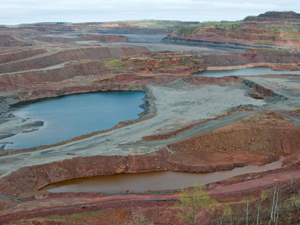MINNEAPOLIS / ST. PAUL — Minnesota’s Iron Range is pocked with ponds – abandoned open pit mines – that could help energy providers more efficiently use intermittent renewable energy sources, such as wind, to meet state renewable energy mandates. A study released Friday by the University of Minnesota Duluth’s Natural Resources Research Institute shows that the water-laden pits have the potential to store wind energy using a process developed in Europe in the late 1800s.
The pumped-hydro storage process would use excess late-night wind energy to pump water uphill from the pits to a higher-elevation holding pond. Then, when electricity demand goes up during the day, the process reverses the flow and captures the energy in hydro turbines. For every 100 megawatts used to pump the water upward, the plant generates nearly 80 megawatts through the turbines.
The study was funded by the university’s Initiative for Renewable Energy and the Environment (part of the Institute on the Environment), with additional contributions from Minnesota Power and Great River Energy. It weighs a variety of considerations necessary to implement the concept using existing reservoirs on the Iron Range.

A study released by the University of Minnesota Duluth’s Natural Resources Research Institute shows that the water-laden pits have the potential to store wind energy using a process developed in Europe in the late 1800s. Image credit: University of Minnesota
Local utilities have invested heavily in wind power, a variable energy resource whose output doesn’t always match customer energy requirements. Market prices can be depressed when wind energy is plentiful, but customer demand for this energy is lower. Pumped-hydro would allow utilities to store excess power when it is not needed by customers and return that power to market during higher demand hours when customer needs are greater. The utility will be able to better integrate wind-type resources into its power supply while maintaining system reliability.
“The altered landscape of the Iron Range makes it ideal for this purpose,” explained Don Fosnacht, NRRI director and the study’s lead investigator. “There are over 100 mining pits, and those near ridges or cliffs would provide the necessary water reservoir prospects to allow the concept to be practically implemented.”
Pumped-hydro storage could have long-range impact on the adoption of renewable energy technologies in Minnesota.
“Minnesota Power will continue to assess energy storage development and the role pumped hydro might play in its long-range plans to best serve our customers,” explained Al Rudeck, vice president of strategy and planning for Minnesota Power. “This study provides a good basis for that continued assessment.”
Rick Lancaster, vice president for generation at Great River Energy, is also enthusiastic about the potential. “We feel that this technology could be a very good fit with our existing wind power and increasing renewable energy requirements,” he said.
Researchers from UMD’s Department of Civil Engineering and the University’s St. Anthony Falls Laboratory and Humphrey School of Public Affairs worked with NRRI on the study. The mission of the Natural Resources Research Institute is to foster the economic development of Minnesota’s natural resources in an environmentally sound manner to promote private sector employment.
The full study report can be viewed online at: www.nrri.umn.edu/egg/pumpedhydro.
*Source: University of Minnesota (Published on December 16, 2011)
